Excessively high exhaust flow in a tight enclosure. Surely no one would be dumb enough to do this? Quick quiz. What is currently the most common ventilation approach in houses, apartments and condominiums? That would be exhaust only ventilation. It is not a very effective method of ventilation. You don’t know where the air is coming from. You don’t have much distribution – if any. You can’t filter the air. But it is cheap and has kinda got the job done for as long as I have been an engineer. But back in the day enclosures were leaky and exhaust flow rates were low. Not any more.
I wonder if anyone has been paying attention while our eager beavers on the ASHRAE Standard 62 committees have been “improving” our air quality. Ventilation flow rates have almost doubled in the last year.1 Two things happened, one a good thing, the other not so much. Standard 62.2 finally got rid of a “default” infiltration credit – the good thing that was supported by all. Unfortunately this was coupled by a large increase in ventilation rates – the not so good thing that was supported by some.
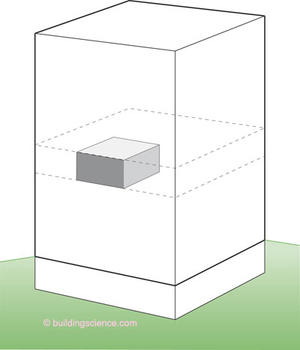
Figure 1: Multifamily Compartmentalization—Individual units are air sealed and tested by pressurization or depressurization for compliance.
It gets better – or worse depending on your perspective. Now we have a “compartmentalization” tightness requirement for apartments and multifamily buildings2 to go with these higher flow rates (Figure 1). We are getting pretty good at compartmentalization (Photograph 1, Photograph 2 and Photograph 3). Not as good as some folks think, see previous footnote, but pretty good.
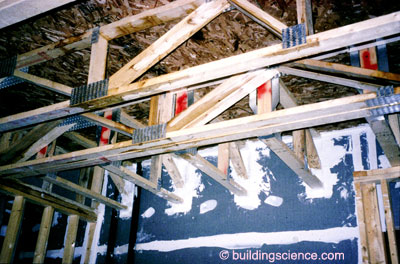
Photograph 1: Compartmentalization Air Sealing—Gypsum board is run up to the underside of the floor sheathing above and sealed with joint compound.
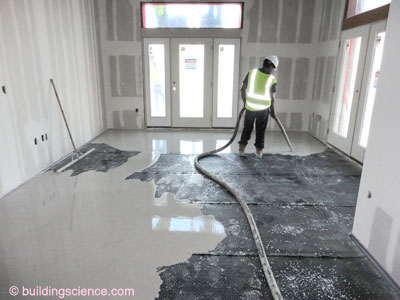
Photograph 2: More Compartmentalization Air Sealing—Bottom of walls are sealed fabulously well when gypcrete floors are used.
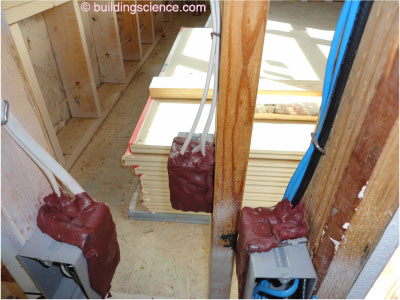
Photograph 3: Airtight Electrical Box—Putty pads are used to seal electrical boxes airtight. Joint compound is used to complete the seal between the electrical box lip and the cut opening in the gypsum board.
If you actually install an exhaust only ventilation system operating at Standard 62.1 or Standard 62.2 rates in an apartment that is compartmentalized to the requirements of Standard 62.2 (or the LEED multifamily compartmentalization requirement if you want to be reasonable) you are going to be operating at a negative pressure for a standard sized apartment – about 750 square feet and two bedrooms.
Now comes the interesting question. Where is the make up air going to come from? It can’t come from the corridor. The corridor doors are also required to be weather-stripped (Photograph 4) and even if they were not weather-stripped and undercut it is a bad idea to do that in any event for smoke control and fire spread reasons. It can’t come from the neighboring units, which was the whole point of the compartmentalization. It has to come from the outside. Duh. But to keep the pressures reasonable you need a really big hole.3 No one is ever going to do this. The big hole will lead to comfort problems (Photograph 5).
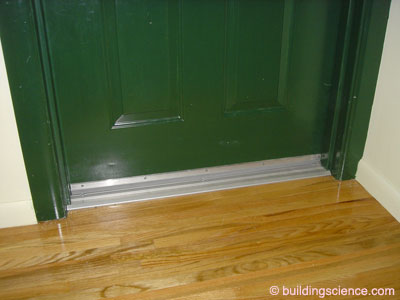
Photograph 4: Weather-Stripped Door—A beautiful thing if you are worried about fires – an ugly thing if you need make-up air.
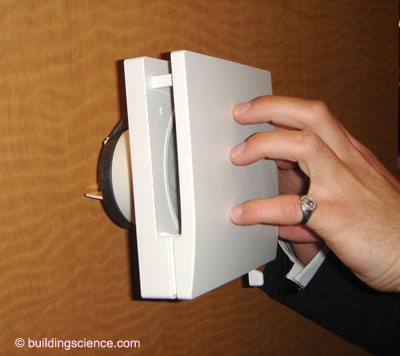
Photograph 5: High Tech Big Hole—Good for about 25 cfm, so you need three or four per apartment. They diffuse the incoming air to avoid cold spots and drafts.
The Standard 62.1 and Standard 62.2 folks say that you are not required to use exhaust only ventilation. You can use supply ventilation or balanced ventilation. That is true. But what is true is that both Standard 62’s effectively eliminate the use of exhaust only ventilation because it no longer can be made to work in apartments and condominiums constructed to the required tightness standards. The only remaining good news is that exhaust ventilation can still be made to work in single-family detached houses without atmospherically coupled combustion appliances – although as an approach exhaust only ventilation is a pretty poor excuse for ventilation.
So how do you actually do this? How do you meet the ventilation rate requirements and the tightness requirements and get something that works? One way is to install a roof top unit that preconditions the air and then duct it down to each corridor and then into each individual apartment unit. You couple this with bathroom exhaust and kitchen exhaust. As an engineer I do not have a problem with this. This is actually pretty darn good. It is just that I don’t think folks understand that there is a new sheriff in town and that this is now the deal.4 What else can you do? You can do a balanced system such as an HRV or an ERV (Figure 2). As an engineer I would love to do this in units. I like Porsches too.
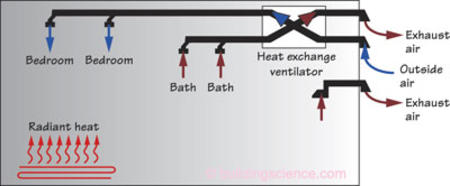
Figure 2: Fully Ducted HRV or ERV—The “Porsche” of ventilation systems. Only slightly less expense than a Porsche …. and certainly not as much fun. Kitchen exhaust is vented separately – not through the HRV or ERV. I prefer not to run the bathroom exhaust through them either, but I am in the minority.
We are not done yet. At the flow rates we are now talking about we have a part load humidity problem is many parts of the Republic. Note that we are actually building energy efficient houses, apartments and condominiums. We have great windows with low SHGC’s, compact florescent lighting and enclosures that are actually insulated well. Ah, here is the rub. No load, no cooling, no dehumidification from cooling. Oops. Now we need dehumidifiers (Figure 3, Figure 4 and Photograph 6) in houses if they are small and for sure we need them in apartments and condominiums.5
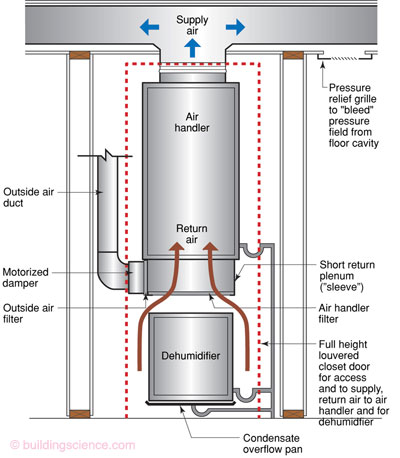
Figure 3: Dehumidifier in Return Closet—Standard off-the-shelf dehumidifier inside a return closet. Works great. Folks hate this because the return is not ducted. Not a rational objection in my view, but what do I know?
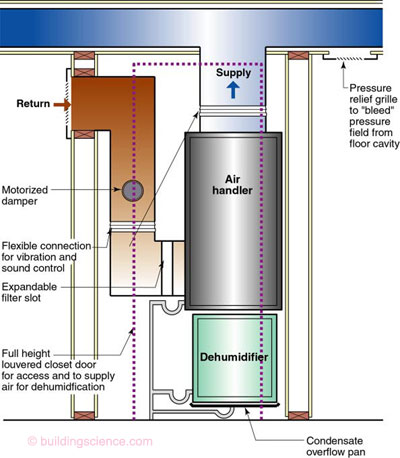
Figure 4: Dehumidifier with Ducted Return—Standard off-the-shelf dehumidifier in a closet with a hard ducted return.
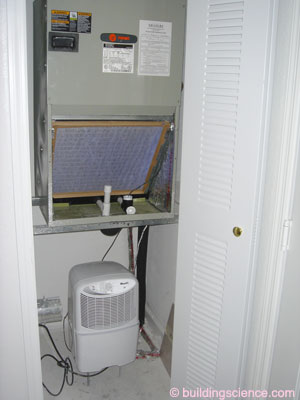
Photograph 6: Low Tech Dehumidifier—One of those standard-off-the-shelf things that are plumbed such that they drain directly into the condensate drain.
This is part where I am going to try to be constructive and make some suggestions on fixing Standard 62.2. Lower the rates for ventilation systems that have good ventilation effectiveness. This will encourage good systems and discourage bad systems. Heresy, I know.
Here is my take on exhaust only ventilation. Extracting air out of one location with an exhaust fan does not help other rooms and does not address the quality or location of the air being drawn into the building. What is the “effectiveness” of the ventilation in a secondary bedroom with an exhaust fan in the master bedroom? With a single point exhaust you need about three times the flow rate compared to supply air ducted to a central air handler that distributes the air an provides mixing to get similar ventilation “effectiveness.” Yet Standard 62.2 treats them the same. To get exhaust only ventilation to work minimally well you need to provide mixing and distribution with the house central air handler, and even then you don’t get to filter the air before you bring it in, you don’t get to pick where the air comes from and you certainly don’t get to precondition it.
No engineer would ever do this in a commercial building. In a commercial building air is brought into the building at a location that is known and selected for the quality of its outside air. This air is then conditioned and distributed throughout the building. A single point exhaust system does none of this and is inherently flawed for this reason.
Exhaust fans should be used to provide spot ventilation or source control for specific contaminants in specific locations. They are ideally suited for use as intermittent bathroom exhaust or intermittent kitchen range hood exhaust.
A fully-ducted and balanced ventilation system, such as an HRV or ERV with spot ventilation via intermittent exhaust fans in bathrooms and the kitchen in a house, apartment or condominium is significantly more effective than single point exhaust. Why not reduce the ventilation flow rates for these systems by 50 percent in Standard 62.2 as compared to the ventilation flow rate for a single point exhaust fan.
Consider something similar for supply systems. Supply systems are much better than exhaust systems and should be rewarded for being so (Figure 5).
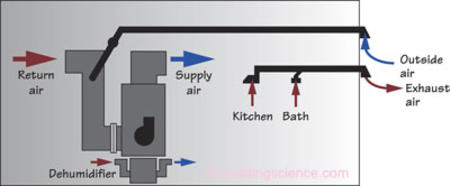
Figure 5: Supply Ventilation System with Intermittent Exhaust—This is a nice system but only works if the outside airflows are low. This system can’t work with the new higher Standard 62.2 flow rates.
Blowing is better than sucking. Sucking and blowing at the same time is better than blowing. And sucking and blowing at the same time with mixing is better still. When you add spot intermittent sucking at bathrooms and kitchens things are fabulous. If you then add energy recovery you are over the top.
But if the only option is sucking over nothing, then suck. Sucking still sucks, but it is better than nothing. But remember you need to suck a lot and sucking a lot has its own problems.
What is discouraging is that we are encouraging poor ventilation systems and approaches through our standards rather than encouraging good ventilation systems. We actually are penalizing good systems. It actually gets worse as we end up over ventilating houses with these poor systems, wasting energy and creating part load humidity problems. This just sucks. If this keeps up we are going to see lots of folks in the dehumidifier business.
Footnotes:
In my opinion there was no justification for the original flow rates except for the worst performing systems such as exhaust only – just a bunch of folks making wild ass guesses. Now we take these unjustified rates and make them even more unjustified. But I am an engineer so I will accept the rates and figure out how to make them work because this is what I do.
It is 20 cfm per 100 square feet of compartment surface area at a pressure difference of 50 Pa for Standard 62.2. Does anyone who voted for this even know what this means? This is ultra tight and not achievable without extraordinary effort. The number comes from one building done in an extraordinary manner in NYC. It is way tighter than the LEED multifamily compartmentalization number which in itself is not easy to do – but can be done with effort. I did not ever think I would say this but the LEED number is a pretty good number. Please don’t tell anyone at LEED that I said something nice about them.
How about a bunch of small holes? How about trickle vents? Sure. Each trickle vent gives you about 7.5 cfm, so you only need 10 of them per apartment. OK this is meant as a joke. It would be dumb to put 10 holes in the wall per apartment.
Actually what this will mean is that Standard 62.1 or Standard 62.2 will not be adopted by most jurisdictions for multifamily construction and they will sit on the shelf like most standards that make themselves irrelevant because they over reach. Standard 62.2 is currently being ignored by the IRC committee for this reason.
Did the folks on the committee that voted for these rates know they were also voting for dehumidification? Interesting question. The comment I got from one luminary is that it is the job of the engineer to figure this out, not the job of the committee. I mentioned the energy penalty as well. The response from another luminary is that the Standard 62.2 is not supposed to consider energy – and it does not consider it. The Standard 62.2 committee has managed in the last set of changes to waste all of the energy the model building codes have saved in the past two decades of encouraging the construction of energy efficient buildings due to the energy penalty from excessively high ventilation rates.
